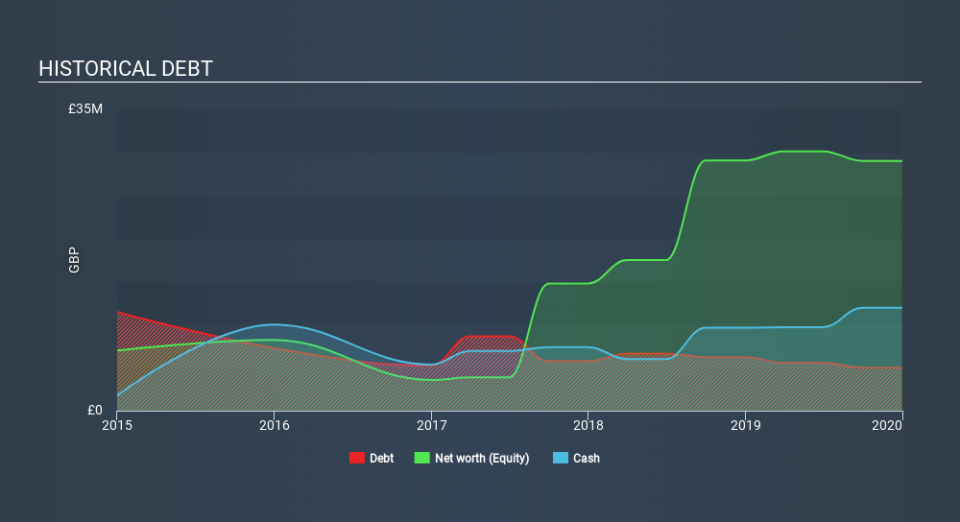Xpediator (LON:XPD) Takes On Some Risk With Its Use Of Debt

David Iben put it well when he said, 'Volatility is not a risk we care about. What we care about is avoiding the permanent loss of capital. When we think about how risky a company is, we always like to look at its use of debt, since debt overload can lead to ruin. We can see that Xpediator Plc (LON:XPD) does use debt in its business. But the real question is whether this debt is making the company risky.
What Risk Does Debt Bring?
Debt is a tool to help businesses grow, but if a business is incapable of paying off its lenders, then it exists at their mercy. If things get really bad, the lenders can take control of the business. However, a more frequent (but still costly) occurrence is where a company must issue shares at bargain-basement prices, permanently diluting shareholders, just to shore up its balance sheet. Of course, the upside of debt is that it often represents cheap capital, especially when it replaces dilution in a company with the ability to reinvest at high rates of return. The first step when considering a company's debt levels is to consider its cash and debt together.
View our latest analysis for Xpediator
How Much Debt Does Xpediator Carry?
You can click the graphic below for the historical numbers, but it shows that Xpediator had UK£5.00m of debt in December 2019, down from UK£6.22m, one year before. However, it does have UK£12.0m in cash offsetting this, leading to net cash of UK£6.95m.
A Look At Xpediator's Liabilities
We can see from the most recent balance sheet that Xpediator had liabilities of UK£72.3m falling due within a year, and liabilities of UK£27.6m due beyond that. On the other hand, it had cash of UK£12.0m and UK£55.3m worth of receivables due within a year. So its liabilities outweigh the sum of its cash and (near-term) receivables by UK£32.6m.
This is a mountain of leverage relative to its market capitalization of UK£35.4m. Should its lenders demand that it shore up the balance sheet, shareholders would likely face severe dilution. Despite its noteworthy liabilities, Xpediator boasts net cash, so it's fair to say it does not have a heavy debt load!
Shareholders should be aware that Xpediator's EBIT was down 28% last year. If that earnings trend continues then paying off its debt will be about as easy as herding cats on to a roller coaster. There's no doubt that we learn most about debt from the balance sheet. But it is future earnings, more than anything, that will determine Xpediator's ability to maintain a healthy balance sheet going forward. So if you're focused on the future you can check out this free report showing analyst profit forecasts.
But our final consideration is also important, because a company cannot pay debt with paper profits; it needs cold hard cash. Xpediator may have net cash on the balance sheet, but it is still interesting to look at how well the business converts its earnings before interest and tax (EBIT) to free cash flow, because that will influence both its need for, and its capacity to manage debt. Over the last three years, Xpediator actually produced more free cash flow than EBIT. That sort of strong cash generation warms our hearts like a puppy in a bumblebee suit.
Summing up
Although Xpediator's balance sheet isn't particularly strong, due to the total liabilities, it is clearly positive to see that it has net cash of UK£6.95m. The cherry on top was that in converted 107% of that EBIT to free cash flow, bringing in UK£12m. So while Xpediator does not have a great balance sheet, it's certainly not too bad. When analysing debt levels, the balance sheet is the obvious place to start. However, not all investment risk resides within the balance sheet - far from it. Consider risks, for instance. Every company has them, and we've spotted 4 warning signs for Xpediator you should know about.
If, after all that, you're more interested in a fast growing company with a rock-solid balance sheet, then check out our list of net cash growth stocks without delay.
This article by Simply Wall St is general in nature. It does not constitute a recommendation to buy or sell any stock, and does not take account of your objectives, or your financial situation. We aim to bring you long-term focused analysis driven by fundamental data. Note that our analysis may not factor in the latest price-sensitive company announcements or qualitative material. Simply Wall St has no position in any stocks mentioned.
Have feedback on this article? Concerned about the content? Get in touch with us directly. Alternatively, email editorial-team@simplywallst.com.

 Yahoo Finance
Yahoo Finance 
